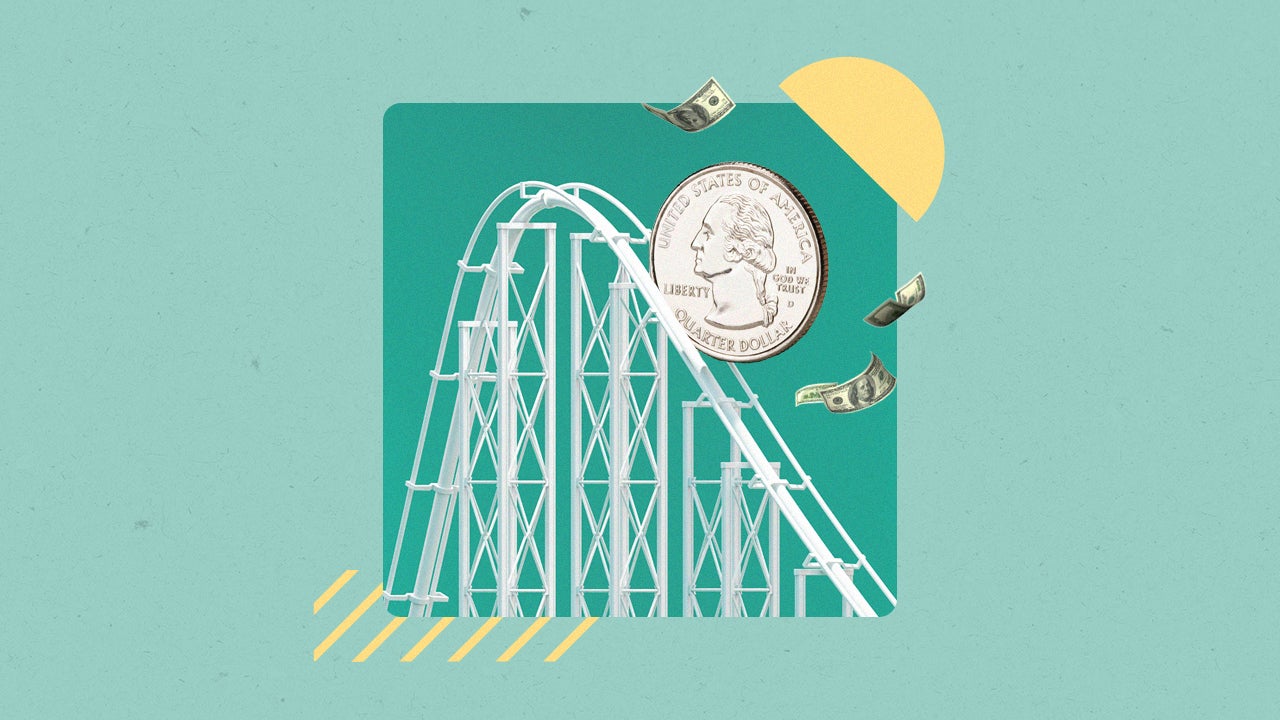Study: Americans’ pay hasn’t fully recovered from inflation. Will it ever?

For 13 years, the 3 percent annual salary boost that Ricardo M. could count on every October felt like a beacon of stability and a nod that his loyalty as a plumbing supply salesman was being rewarded.
But in the aftermath of a post-pandemic inflation surge, those raises have since lost their luster. His grocery bills have doubled. The cost of filling up his Toyota 4Runner has jumped to $70 a week, and he’s had to dip into his savings to avoid taking on credit card debt. All the while, his pay increases have stayed the same.
“Inflation has taken it all,” says Ricardo, a California resident who requested that his last name be abbreviated, so he could speak freely about his employment situation. “I know costs are going up everywhere, and I understand that a business has to make money and stay profitable. But at the same time, don’t forget about the people who are bringing you business. I don’t make enough for the sales that I generate.”
Economists have celebrated inflation’s rapid descent, and perhaps even more, the relatively little pain it’s caused the U.S. job market. For over a year now, wages have been rising faster than inflation as prices slow and the job market holds up, giving Americans an opportunity to recover the buying power that they lost after ultralow interest rates, supply shortages and a stimulus check-fueled spending boom combined to form the worst inflation crisis in 40 years.
But the race isn’t over yet. The past 16 months of “real” wage growth — as economists have called it — haven’t been enough to offset the 25 months where prices were rising disproportionately faster than Americans’ paychecks, according to a new analysis of Bureau of Labor Statistics data from Bankrate.
Bankrate’s 2024 Wage To Inflation Index
Since the beginning of the post-pandemic inflation surge in Jan. 1, 2021, prices have risen 20.0 percent, compared with a 17.4 percent increase in wages over the same period, Bankrate’s second-annual Wage To Inflation Index found.
Inflation feels akin to taking a pay cut, helping explain why Americans have been so downtrodden about the U.S. economy. Despite a half-century low unemployment rate at the time, the majority (59 percent) of Americans said in a Bankrate poll from December 2023 that they felt like the U.S. economy was in a recession.
Americans could even take these frustrations to the voting booth come November. Most adults (89 percent) say the economy will be an important factor in determining their vote, with two-thirds (62 percent) calling it very important, according to Bankrate’s Biden and Americans’ Personal Finances Survey from November 2023.
To be sure, some ground has already been recovered. Thanks to over a year of “real” wage growth, the current gap between wage growth and inflation (2.6 percentage points) marks major improvement from when it was at its widest in the summer of 2022 (3.9 points).
Yet, wages have recently lost some momentum. In Bankrate’s 2023 index, Americans’ paychecks were on track to fully recover from post-pandemic inflation by the fourth quarter of this year. Now, Americans’ paychecks are on pace to bounce back by the end of the second quarter of 2025, updates to Bankrate’s index for 2024 found.
What was a previously red-hot job market is now a pretty normal-ish job market. Bargaining power, broadly speaking, has also moderated and normalized.— Mark Hamrick, senior economic analyst at Bankrate
The job market has cooled more than expected this year
Wages are taking longer to recover amid a faster-than-expected cooldown in the job market, which has already stripped workers of some of their bargaining power to ask for higher pay.
Between the second quarter of 2023 and 2024, prices rose 3.194 percent, nearly matching the 3.187 percent expected increase from last year’s index. Wages, however, rose 4.03 percent over the same period, after previously being on pace to grow 4.6 percent.
The labor market functions much like any other open market, economists say. Wage growth is often a reflection of who has the upper hand: the employer or the employee.
When there are too many job openings and not enough workers, employers compete for talent by lifting pay or offering big bonuses. But too few jobs for the number of people seeking work might make Americans hesitant to leave their current positions, wary about how greener other pastures might actually be in a more competitive job market.
If they’ve been on the hunt for a while, they might be inclined to settle for a job that pays less. And if they’re so inclined to negotiate for higher pay, they might not ask for as much.
“We’re seeing wage growth cool because demand is falling,” says Sam Kuhn, labor economist at Appcast, a recruiting platform. “In 2022, there were serious labor shortages. As that gap has closed, there’s just less incentive to give out higher wages or yearly raises.”
Illustrating the shift, there’s now just one job opening per every unemployed worker, the smallest ratio since April 2018, Bureau of Labor Statistics data shows. Employers have created an average 96,000 jobs in the private sector over the past three months, a massive slowdown from a three-month moving average of 203,000 in March. The hiring rate, meanwhile, has plunged to levels that are even lower than they were before the pandemic. Unemployment is now the highest since before the pandemic.
ADP’s Chief Economist Nela Richardson has watched wage growth for job changers dip from a high of 16.4 percent in June 2022 to the most recent level of 7.3 percent, according to data that her firm collects. Americans who’ve stayed at their current positions, meanwhile, saw their pay increase 4.8 percent for the second month in a row, ADP data also shows. In the leisure and hospitality sector, Richardson says she’s starting to notice that workers are accepting new positions for less pay than they were making previously — echoing trends from before the pandemic and painting a picture of a slowing labor market.
“There’s a lot of reasons workers switch jobs that aren’t tied primarily to compensation,” she adds. “It could be a better shift, a better team, a better location.”
What happens next for the U.S. job market can have grave implications for Americans’ prospects of catching up. In June, economists projected that job growth over the next year would average 115,000 jobs a month, Bankrate’s quarterly Economic Indicator Survey found. That would represent an even sharper slowdown in labor demand, with job growth currently averaging 197,000 over the past 12 months.
A cooling economy means less inflation, but slower wage growth, too, setting Americans back in their game of catch up. Richardson says a valid concern is whether their wages will recover at all.
“Will workers make up the ground lost when real wages weren’t growing with inflation? From what I see in key sectors, the answer is not likely,” Richardson says. “It’s really about can the wage level remain above current inflation, to get a better picture for workers.”
Not all workers have lost ground to inflation
Some workers are even further ahead — or behind — in their race against inflation, depending on the specific industry in which they work.
Bankrate’s analysis found that pay has risen faster than inflation in two industries: leisure and hospitality (23.7 percent) and accommodation and food services (23.3 percent), compared with a 20 percent rise in prices from the start of 2021 to the end of June. Paychecks are furthest behind in education (13.6 percent), construction (14.1 percent) and financial activities (14.3 percent) during that same timeframe.
Meanwhile, after increasing at a faster rate than inflation in Bankrate’s 2023 Wage to Inflation Index, pay in the retail sector (up 19.4 percent since the beginning of 2021) has since fallen behind.
The industries where wage growth has boomed correspond with where labor demand was the strongest. At one point, a record 11.1 percent of jobs within the accommodation and food services sector and 10.9 percent of positions within leisure and hospitality were vacant, the most of any other industry. On the flip side, job opening rates in the industries with the slowest wage growth peaked at much lower levels, with construction at 5.4 percent and education hitting 4 percent, according to Bankrate’s analysis.
That’s not to say Americans in inflation-beating industries are feeling particularly better off. The average hourly earnings of workers in the financial activities sector ($45.73), for example, are more than two times as high as those in leisure and hospitality ($22.18).
The more money workers make, the better positioned they are to absorb higher prices in their budgets. Low-income households tend to spend more money on essentials that they can’t cut back on, whereas upper-income Americans have more options to free up cash, such as trimming discretionary spending or their savings contributions.
Workers making less than $50,000 a year (at 43 percent) were nearly twice as likely as those who earn $100,000 or more a year (24 percent) to feel that they’re living paycheck to paycheck, according to a Bankrate survey from July.
Americans working jobs in retail, leisure and hospitality and food services were also more likely to have lost their jobs during the pandemic, making it hard to say whether they’re truly better off today, says Elise Gould, senior economist at the independent Economic Policy Institute.
“Even if their wages have risen, it has been very hard for people to make ends meet on the kinds of wages that our labor market has been delivering over the last 50 years,” Gould says. “But the fact that people are struggling doesn’t mean that they didn’t experience real wage growth. Both things can be true.”
‘I don’t know if it’ll get as good as it was’
Robert Santy, a psychotherapist based in Connecticut, has taken on 20 extra clients in the four years since the pandemic. He says the decision was equal parts personal necessity and societal urgency.

For starters, every corner of Santy’s budget has grown more expensive. Car insurance for his family of five is costing him $10,000 a year. His monthly electric bills often range between $600-$800. His cell phone bill jumped by $40 a month, and even his grocery costs can easily reach $1,000 a week. He’s taken on longer hours simply to replace some of his lost income.
“It’s nickel and dime, nickel and dime, and everyone wants a piece of the pie,” he says. “My pie keeps getting smaller and smaller and smaller.”
But whether it’s lingering stress from the pandemic or financial anxieties surrounding inflation and recession fears, Santy says he’s been in no need for clientele over the past four years, either. He often takes calls from patients after hours and goes to his office on weekends to catch up on paperwork. He estimates that he gets about four cold calls a week from new, inquiring clients, whom he has to turn away because he doesn’t have enough room for them in his schedule.
“People are highly stressed, highly anxious, struggling financially. That leads to family squabbles, relationship issues,” he says. “You get the cable company, the electric company, the cell phone company, your mortgage goes up, your taxes go up. Any one thing might be manageable, but when it’s death by a thousand needles, that just wears on people over time.”
Contributing to his rising expenditures, his two youngest children are in college, while his oldest daughter is living at home on an extended job hunt after graduating two years ago. Him and his wife are now earning nearly $300,000 a year as a household, but they feel like they had an easier time getting by when they were in their early 20s, earning just $22,000 a year. Still feeling surprised by bills or unexpected expenses, he’s had to temporarily halt his retirement contributions.
“I’m certainly in better shape financially than I’ve ever been in my life, but I’m not where I thought I was going to be or where I think I should be,” Santy says. “It’ll get better, but I don’t know if it’ll get as good as it was. I realize everything goes up and up and up, but did it have to go up so much so quickly when I didn’t have time to adjust? It felt like it just happened overnight.”
Even if wages recover, inflation may have already damaged the American psyche
Americans look at inflation differently than economists. Analysts track annual rates of change in inflation to determine whether the U.S. economy is overheating, while the typical American consumer focuses on how much the items they see everyday have risen in cost.
Just 6 percent of the nearly 400 items the Bureau of Labor Statistics tracks are cheaper today than before the pandemic, a Bankrate analysis of inflation data shows. Key essentials that consumers regularly buy — like gasoline, groceries, utilities, rent and more — have risen at a faster rate than overall inflation. Car insurance, meanwhile, is up almost 50 percent since February 2020.
Inflation can have a profound effect on consumer psychology. Nearly half of adults (47 percent) say money has a negative impact on their mental health at least occasionally, Bankrate’s Money and Mental Health Survey from May 2024 found. Almost two-thirds of them (65 percent) cited rising prices as a reason.
“It will require that workers continue to enjoy some restoration of buying power through real wage gains,” Hamrick says, referring to when Americans could start to feel better. “To the extent we see falling prices for goods within a fairly normal, not recessionary, economic environment, that would be helpful.”
Money tip: If you’re still feeling the pinch of inflation, don’t forget to comparison shop and price check to ensure you’re getting the best deal on what you’re buying.
Bankrate’s take: Periods of high inflation underscore the importance of making sure every dollar in your wallet is accounted for. Keep a close watch over your budget and try to find a way to grow your purchasing power.
Keep in mind: High-yield savings accounts are offering 5 percent or more a year in interest, beating the overall rate of inflation.
Ricardo is already gearing up for his annual review next month. He’s preparing to make a case for why he deserves a bigger raise than usual, citing his sales numbers and translating how it adds to his company’s bottom line. He hopes to use the money to visit his five grandchildren, who live across the country in both Florida and Seattle.
But even if he doesn’t get the money he’s hoping for, he says he’s unlikely to quit. He hopes to retire within the next few years and is afraid of taking a pay cut by starting over somewhere else.
“I’m waiting for them to one day tell me, ‘Don’t worry, we’ll take care of you.’ That’s what you want to hear after 16 years,” he says. “Hopefully, I don’t get disappointed with what I’m going to hear.”






